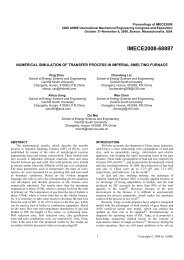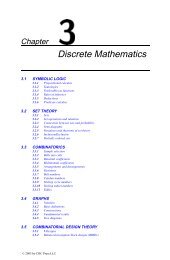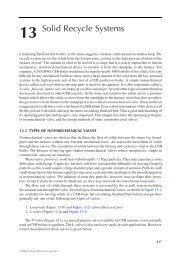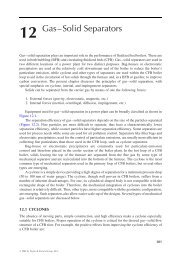Chapter 4: Geometry
Chapter 4: Geometry
Chapter 4: Geometry
You also want an ePaper? Increase the reach of your titles
YUMPU automatically turns print PDFs into web optimized ePapers that Google loves.
FIGURE 4.21<br />
The semi-cubic parabola, the cissoid of Diocles, and the witch of Agnesi.<br />
<br />
È<br />
<br />
È<br />
<br />
<br />
Ç<br />
diameter <br />
Ç<br />
diameter <br />
More generally, any curve of degree three with equation ´Ü Ü ¼ µÝ ¾ ´Üµ,<br />
where is a polynomial, is symmetric with respect to the Ü-axis and asymptotic<br />
to the line Ü Ü ¼ . In addition to the cissoid, the following particular cases are<br />
important:<br />
1. The witch of Agnesi has equation ÜÝ ¾ ¾´ ܵ, with ¼, and is<br />
characterized by the geometric property shown in Figure 4.21, right. The same<br />
property provides the parametric representation Ü Ó× ¾ , Ý ØÒ .<br />
Once more, proportional scaling reduces to the case ½.<br />
2. The folium of Descartes (Figure 4.22, left) is described by equation ´Ü<br />
µÝ ¾ Ü ¾´ ½ Ü · µ, with ¼(reducible to ½by proportional scaling).<br />
By rotating 135 Æ (right) Ôwe get the alternative and more familiar equation<br />
¿<br />
Ü ¿ ·Ý ¿ ÜÝ, where ½ ¾. The folium of Descartes is a rational curve,<br />
¿<br />
that is, it is parametrically represented by rational functions. In the tilted position,<br />
the equation is Ü Ø´½ · Ø ¿ µ, Ý Ø ¾ ´½ · Ø ¿ µ (so that Ø ÝÜ).<br />
3. The strophoid’s equation is ´Ü µÝ ¾ Ü ¾´Ü · µ, with ¼(reducible<br />
to ½by proportional scaling). It satis es the property È È ¼ Ç<br />
in Figure 4.22, right; this means that ÈÇÈ ¼ is a right angle. The strophoid’s<br />
polar representation is Ö Ó× ¾ × , and the rational parametric representation<br />
is Ü ´Ø ¾ ½µ´Ø ¾ ·½µ, Ý Ø´Ø ¾ ½µ´Ø ¾ ·½µ(so that Ø ÝÜ).<br />
Among the important curves of degree four are the following:<br />
1. A Cassini’s oval is characterized by the following condition: Given two foci<br />
and ¼ , a distance ¾ apart, a point È belongs to the curve if the product of<br />
the distances È and È ¼ is a constant ¾ . If the foci are on the Ü-axis and<br />
equidistant from the origin, the curve’s equation is ´Ü ¾ · Ý ¾ · ¾ µ ¾ ¾ Ü ¾ <br />
. Changes in correspond to rescaling, while the value of controls<br />
© 2003 by CRC Press LLC










